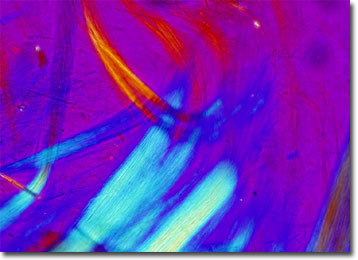Polarized Light Microscopy Digital Image Gallery
Short Asbestos Fibers
Asbestos is a generic term used to refer to six different types of naturally occurring mineral fibers. The most familiar type of the material and that which is in greatest commercial use is chrysotile, a form of the mineral serpentine.

Utilized since antiquity, asbestos is primarily valued for its fire resistance, but is also appreciated for its strength, low electrical conductivity, and elasticity. The fiber was not commercially produced on a massive scale, however, until the latter part of the nineteenth century when mining operations began in Italy and then Canada. For about 100 years, asbestos was widely utilized for a variety of applications. The longer fibers that were obtained were commonly spun into yarn used in break linings and insulation, while short asbestos fibers were generally included in paper products and cement-based building materials. However, since the 1970s there has been tremendous concern about the carcinogenic properties of asbestos and numerous restrictions on its production and use have been established in the United States and many other countries.
Many scientific studies have linked asbestos exposure with lung disease and cancers of the chest and abdomen. However, since the term asbestos refers to a variety of mineral fibers, some researchers believe that additional studies should be carried out on the individual fiber types. Thus, if some of the fibers are found to be less likely to cause adverse health effects, they could be regulated separately from the more harmful varieties. Nevertheless, until such investigations can be carried out, all asbestos is under suspicion and should be handled with caution.
